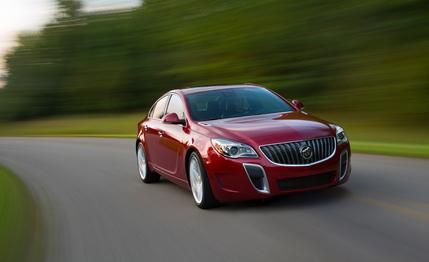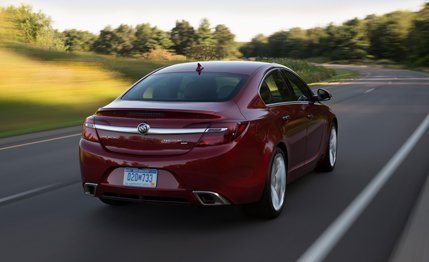 First Drive Review
First Drive Review
Buick’s ambitions for this mid-cycle refresh of the Regal, the brand’s middle sedan introduced in 2011, could be read in the presence of an Audi A4 provided for comparison at GM’s proving ground in Milford, Michigan. Our drive was limited to the facility’s ride-and-handling test route and a tight slalom, but we weren’t immediately convinced that this Regal was the Audi’s equal as a sports sedan. But then neither is it the German’s equal in price, and the comparison wasn’t as laughable as it might have been in the past.
The 2014 Regal is recognizable for new fascias front and rear, a dressier cabin environment, and an array of safety-oriented electronic driving aids, but the major change is the addition of a Haldex all-wheel-drive system available on most models and a new, more-refined direct-injected turbocharged 2.0-liter four as the standard engine.
Stronger than Audi’s equivalent mill and rated at 259 horsepower, this turbo engine is of the same displacement as before but employs new architecture that emphasizes low-friction technologies for quieter operation, improved fuel economy, and higher output. The 2.0-liter turbo brings 39 additional horsepower over last year’s Regal Turbo model, but it’s also the engine for the sporty GS, which means the performance variant gets an 11-hp downgrade from last year. Fuel economy on the base configuration ($30,615) is said to improve by 17 percent even with the increased power.
Distinguishing the more-driver-oriented GS is a tuning tweak that moves the torque peak of 295 lb-ft down the tach (from 3000 rpm in the regular Regal to 2500 rpm in the GS), supposedly at the cost of some NVH that we never noticed. All Regals use the same engine and six-speed automatic transmission with two exceptions, both of them front-drive-only configurations.

The first is a fuel-economy special that relies on last year’s base engine, the naturally aspirated 182-hp 2.4-liter with eAssist “light electrification.” This is essentially stop-start functionality and some electric torque boost while under way. (This powertrain is a no-cost option on Premium trim levels, which start at $32,485.) It earns EPA ratings of 25 mpg city and 36 highway compared with the turbo-and-automatic combo’s 21/30 in front-drive form and 19/27 with four-wheel drive.
There’s one manual-transmission offering, a six-speed in the front-wheel-drive GS that gets 22/31 in the EPA tests. It might have been our favorite if the manual had been more entertaining to use, but the shifter and the clutch action were dull workaday machinery. The turbo’s broad torque band doesn’t really encourage much shifter play, anyway.
More interesting was the all-wheel drive and its electronic limited-slip differential—a real one, not one of those hyperactive brake-operated traction-control systems that try to mimic LSD operation. The Haldex system can direct more than 90 percent of the torque to the rear axle, making it possible, entertaining even, to balance the car’s cornering attitude with your right foot. Electronically controlled, it proved more fun in the tight corners of an autocross course, anticipating and reacting more quickly than Audi’s mechanical Quattro system. We wonder how much time Buick (or even Audi A4) owners spend terrifying tiny orange cones, but the Buick had the edge on the German car in these circumstances.